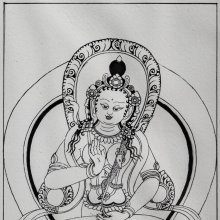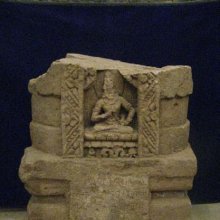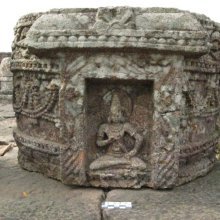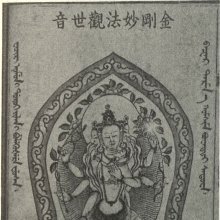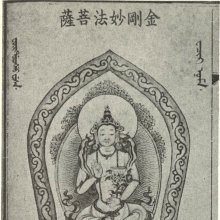Vajradharma, Vajra-dharma, Vajradharmā: 3 definitions
Introduction:
Vajradharma means something in Buddhism, Pali. If you want to know the exact meaning, history, etymology or English translation of this term then check out the descriptions on this page. Add your comment or reference to a book if you want to contribute to this summary article.
Images (photo gallery)
(+4 more images available)
In Buddhism
Tibetan Buddhism (Vajrayana or tantric Buddhism)
Source: Wisdom Library: MañjuśrīnāmasaṃgītiVajradharma (वज्रधर्म) is one of the sixteen samādhi deities appearing in the Vajradhātu-mahāmaṇḍala, according to the Nāmamantrārthāvalokinī v5.32-35. The Nāmamantrārthāvalokinī (literally, ‘an explanation of the nāma-mantras’) is a commentary (ṭīkā) on the 8th century Mañjuśrīnāmasaṃgīti.
Vajradharma is a name of Mañjuśrī (the embodiement of non-dual knowledge) and, together with other names, forms the core essence of the Mañjuśrīnāmasaṃgīti. The Nāmamantrārthāvalokinī provides the practitioner a sādhana (‘meditative practice’) to turn these names into mantras. These mantras are chanted for the benefit of all beings, and then placed and contemplated in the Vajradhātu-mahāmaṇḍala, which is an extended version of the Vajradhātu-maṇḍala.
Source: archive.org: The Indian Buddhist Iconography1) Vajradharma (वज्रधर्म) or Vajradharmalokeśvara refers to one of the various forms of Avalokiteśvara having their Sādhana described in the 5th-century Sādhanamālā (a collection of sādhana texts that contain detailed instructions for rituals).—His Colour is reddish-white.—One Sādhana in the Sādhanamālā describes this form [viz., Vajradharma] of Avalokiteśvara. The distinguishing feature of this god is that he rides a peacock.
The Dhyāna (meditation instructions) of Vajradharma described in the Sādhanamālā as follows:
“The worshipper should conceive himself as excellent Vajradharma, of reddish-white complexion, bright as the padmarāga gem, who bears the effigies of the Five Dhyāni Buddhas on the crown. His eyes beam with delight; and he holds with pride the stem of a lotus with sixteen petals in his left hand and with the right causes it to blossom against his chest. He sits on the moon over lotus on the back of a peacock, enjoys his seat of the animal and displays the delightful sentiment of amour. He moves in the sanctum of the caitya, the place for great performances. He (the worshipper) certainly receives the Bodhi who meditates (upon him) in this manner”
2) Vajradharma (वज्रधर्म) or Vajradharmalokeśvara refers to number 23 of the 108 forms of Avalokiteśvara found in the Machhandar Vahal (Kathmanu, Nepal). [Machhandar or Machandar is another name for for Matsyendra.].
Accordingly,—
“Vajradharma is one-faced and two-armed and sits in the Vajraparyaṅka attitude on a lotus. The right hand displays the Abhaya pose and the left on the lap holds the stem of the Utpala”.
The names of the 108 deities [viz., Vajradharma] possbily originate from a Tantra included in the Kagyur which is named “the 108 names of Avalokiteshvara”, however it is not yet certain that this is the source for the Nepali descriptions.Source: OSU Press: Cakrasamvara Samadhi
Vajradharma (वज्रधर्म) refers to the “Vajra Dharma” [i.e., namas te vajra-dharmāgre], according to the Guru Mandala Worship (maṇḍalārcana) ritual often performed in combination with the Cakrasaṃvara Samādhi, which refers to the primary pūjā and sādhanā practice of Newah Mahāyāna-Vajrayāna Buddhists in Nepal.

Tibetan Buddhism includes schools such as Nyingma, Kadampa, Kagyu and Gelug. Their primary canon of literature is divided in two broad categories: The Kangyur, which consists of Buddha’s words, and the Tengyur, which includes commentaries from various sources. Esotericism and tantra techniques (vajrayāna) are collected indepently.
See also (Relevant definitions)
Partial matches: Vajra, Dharma, Tarma.
Starts with: Vajradharmakaya, Vajradharmalokeshvara.
Full-text: Dharmagra, Vajradharmalokeshvara, Raktalokeshvara, Lokanatha, Ashtabhujakurukulla.
Relevant text
Search found 7 books and stories containing Vajradharma, Vajra-dharma, Vajradharmā, Vajra-dharmā; (plurals include: Vajradharmas, dharmas, Vajradharmās, dharmās). You can also click to the full overview containing English textual excerpts. Below are direct links for the most relevant articles:
The Indian Buddhist Iconography (by Benoytosh Bhattachacharyya)
Guhyagarbha Tantra (with Commentary) (by Gyurme Dorje)
Text 22.1 (Commentary) < [Chapter 22 (Text And Commentary)]
Commentary 1.5: The means of Restoring the Commitments < [Chapter 19 (Text And Commentary)]
Text 11.17 (Commentary) < [Chapter 11 (Text and Commentary)]
Blue Annals (deb-ther sngon-po) (by George N. Roerich)
Chapter 2 - Guhyasamāja-tantra system of Noble Nāgārjuna < [Book 7 - The preaching of the Tantras]
Stupas in Orissa (Study) (by Meenakshi Chauley)
Drum slabs at at Ratnagiri < [Chapter 4]
Minor Votive Stupas at Ratnagiri < [Chapter 4]
The Practice Manual of Noble Tārā Kurukullā (by Dharmachakra Translation Committee)
The Great Chariot (by Longchenpa)
Part 3a.2 - The divisions of root and branch samayas < [B. The explanation of meditation practice, together with its action of ripening and freeing]
Related products
